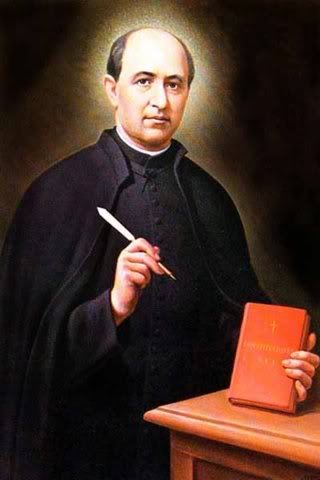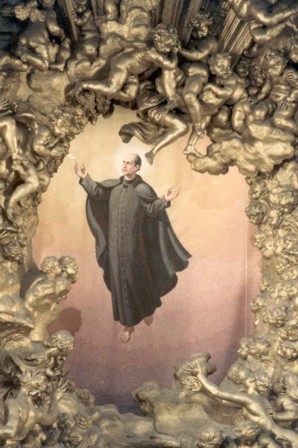Father Henry de Osso-Cervello was born in Vinebre, Spain, on October 16, 1840. He was one of those persons of whom it is said that God sends one every hundred years to help resolve the conflicts of their times.
It is not easy to sum up briefly all the details of his heroic life. We can get a glimpse by turning our attention to three of the most striking characteristics of this great apostle of the nineteenth century: he was a man of God; a man sent by Providence; a man determined to seek God’s glory in all things.
A MAN OF GOD
His spirit of faith was evident from his early years. It was nourished and developed until it became the hallmark of his spirituality. Osso was a man of profound spirituality. His thoughts, words, deeds — his whole life, in fact — were directed towards God. At the age of six he would stop playing and leave his friends to join the parish priest whenever he knew he was taking the Blessed Sacrament to a sick person.
His father sent him to be a clerk in a dry goods store in Reus while he was still a young boy, in the hope that he would become a successful business man. While there, Henry became concerned over the bad influence some friends, with whom he came in contact in the business, could have on him.
Consequently, he secretly left for the Monastery of Our Lady of Montserrat, near Barcelona, where he would dedicate his life to God. In a farewell letter to his father, he wrote:
Soon after this, we find him in the seminary in Tortosa and later, in that of Barcelona. In both places he was an example of virtue to his friends, who never used improper language or gestures in his presence.My absence will cause you sadness but Father, it is the glory of God that motivates me. Your sorrow will be turned to joy if only you remember that we will soon meet again in heaven… Give my clothes and other belongings to the poor… Life is short and riches serve no purpose unless we use them well.
He chose a spiritual director whose advice he followed always. With his director’s approval, he drew up a plan of life which he followed. He prefaced it thus:
During the spiritual exercises that he made in preparation for his Subdiaconate, he added the following to his plan:As a help to my spiritual formation, I will, with God’s grace, engrave firmly in my mind Saint Teresa’s words: Let the world perish before I offend God because I owe more to God than to anybody else.
Learn of me, for I am meek and gentle of heart.
Goal: to imitate Jesus in my thoughts and actions so that others can say of me what they used to say of Saint Francis de Sales: This is how Jesus acted.
Once ordained to the priesthood, he transformed his passionate love for God into dedicated ministry, and soon became known as a model priest. Without neglecting his classes in the Seminary, he exercised his priestly ministry everywhere, among all social classes, preaching, encouraging, giving retreats, teaching religion to the children. He communicated his apostolic zeal wherever he went. His deep spirit of faith was reflected in his prayer as well as in all that he did. His devotion while celebrating the Eucharist moved many to repentance and love of God.Prayer: Spirit of God, on the eve of Pentecost, I ask for this grace: Since I will soon consecrate myself to God in a special way as his temple and minister forever, fill me with your holy gifts. Grant me the spirit of prayer and zeal like that of the apostles. Fill me especially with the gifts of wisdom and fear of the Lord. Come, Holy Spirit.
“Who is that priest?” asked certain visitors who saw him celebrate Mass in Rome, so inspired were they by his fervor and devotion. At times he seemed transported out of himself. It was not unusual to hear him sigh gently, as though enraptured: My Jesus and my all. To love you or to die. Rather, to live and die loving you above everything else. Do not let me leave this world without having loved you and made you known and loved as much as I can. Give glory, honor and riches to others, but give me, your servant, only your love and that will be enough. My Jesus and my all. Praised be Jesus my love. All for Jesus! Praised be Jesus!
Such was his priestly concern, the cry of his loving heart. And such was the motto that he left to the religious that he founded, the Teresian Sisters, who often echo his words: All for Jesus! Praised be Jesus!
A MAN SENT BY PROVIDENCE
Another extensive field for his apostolic zeal opened up before him after his first Mass on October 6, 1876. The Revolution of 1868 resulted in a lowering of morals in Tortosa. To fight this evil, Henry obtained the permission of his Bishop, Dr. Vilamitjana, to organize twelve catechetical centers, which soon had an enrollment of 1,200 children. God poured abundant blessings on Tortosa by means of these centers.
His ministry was most effective and extensive. Among others, the following apostolic groups are better known:
The Teresian Apostolic Movement (TAM), which he founded to teach children and youth to pray according to the spirituality of Saint Teresa, spread rapidly in Spain. He established it in more than twenty parishes and the enrollment reached more than 130,000 during his life. Today it flourishes wherever the Teresian Sisters are.
The Brotherhood of Saint Joseph, a pious association for older men, started in Tortosa, enlisted some two hundred men from its beginning. Its rapid development was a sign that Father Henry’s ministry was pleasing to God.
Father Henry directed a pilgrimage to Rome, the outcome of his appreciation to the Pope and devotion to the Church. Eight hundred pilgrims went. He also organized another pilgrimage to Avila, birthplace of Saint Teresa, and to Alba, where she was buried. During this pilgrimage, he inspired everyone by his spirit of self-giving, self-sacrifice and humility, which let him forget himself and disappear at the hour of triumph — he who had been the main organizer of the pilgrimage.
He was also instrumental in establishing a monastery of Discalced Carmelite nuns in Tortosa. These and many other forms of ministry, to which we could not possibly give space here, filled the life of this man who spent himself to make God known and loved.
But Father Henry’s great accomplishment in life was the foundation of the Society of Saint Teresa of Jesus, which he was inspired to found while at prayer during the night of April 2, 1876. With the approval of his spiritual director and the blessing of the Bishop, he established the Society, known as the Teresian Sisters, on June 23 of the same year, at the cost of innumerable sacrifices. To the sisters of the new congregation he wrote:
He started the Society with only eight young women. Soon, however, it spread throughout Spain, Portugal, Africa, as well as North and South America. More than 5,000 Teresians have passed through the fourteen novitiates of the Institute. Today, it staffs more than one hundred schools around the world, in addition to many missions in Africa, Nicaragua, Mexico and all through Central and South America. The Teresians also staff houses of prayer in different parts of the world.What we had in mind for this work of zeal was to make you other Teresas, in so far as possible, so that you might be foremost in promoting the honor of Jesus. Praying, teaching, and sacrifice is the aim of the Society. You must work wholeheartedly to promote the honor of Jesus and to restore all things in Christ by educating women according to the spirituality of Saint Teresa of Jesus.
In the midst of his multiple activities, Father Henry also found time to devote to the apostolate of the pen. His first effort was a weekly newspaper entitled The People’s Friend. He was editor of Saint Teresa’s Magazine until his death. Among his many writings, the following publications are significant:
The Catechist Manual
Fifteen Minutes of Meditation
Handbook of TAM
Handbook of Friends of Jesus
Treasure Chest for Children
Novena to Saint Joseph
The Spirit of Saint Teresa
Saint Teresa’s Month
A Tribute to Saint Francis de Sales
Novena to the Holy Spirit
Novena to the Immaculate Conception
He also published textbooks for the schools where the Teresian Sisters taught.
His dynamic life, clear vision, and high ideals went hand in hand with his gentleness, simplicity, and modesty, characteristics that made Henry de Osso very attractive in his ministry. His biographer states: “Whoever saw him never forgot him. His personality attracted the respect and affection of all who approached him.”
Henry’s personality was so pleasant, sincere and natural that, unaware to him, one often sensed his virtue and magnanimous heart. “Our Founder’s presence encouraged us and made us happy. I always saw him act, speak, teach, and advise others as a saint would. His conversation always energized me. His mere presence communicated a certain experience of holiness.” These are some of the reactions of those who knew him.
The one who characterized him best, however, was his intimate friend, Father Francisco Marsal, when he said: “The servant of God, Henry de Osso, was the most faithful model of Jesus Christ that I have ever seen. His speech, conduct, and actions always made me think: That is how Christ acted.”
God, who wanted to make His servant holy, gave him a taste of the bitter chalice of Jesus’ own passion. As He does with those He loves most, He made him go through Calvary before entering into glory. But the displeasures and bitter trials he underwent only served as coals to light the fire of God’s love in his heart. “Jesus is loved very little”, he said to two sisters shortly before his death. “Let the three of us write a booklet on how to increase the love of Jesus in the world.”
A few days later, on January 27, 1896, he went home to His Father, after having made a fervent retreat in his favorite place of solitude, the Franciscan monastery of Sancti Spiritus in Gilet.
On the day he died, he appeared to several persons in Spain and America. He was buried in the Franciscan cemetery in Gilet, where his body remained until 1908, when his remains were transferred to the chapel of the novitiate of the Society of Saint Teresa of Jesus in Tortosa, Spain. On October 16, 1979, he was beatified by Pope John Paul II. After the approval of a new first-class miracle in Uruguay, Father Henry was declared Saint by Pope John Paul II in Madrid, Spain, on June 16, 1993. The Church, whom he loved so much and served so faithfully, rejoices today as she offers this model of holiness to the world.


No comments:
Post a Comment